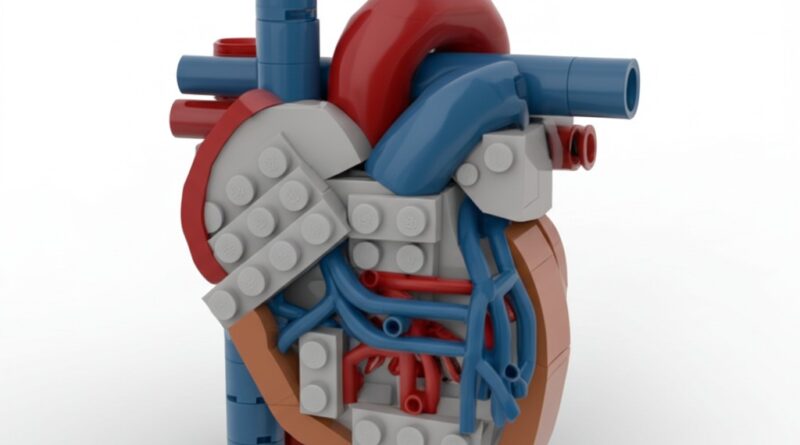Lego Heart Anatomy: Building the Human Heart Brick by Brick
Ever wondered what the inside of your heart looks like—Lego-style?
Welcome to the fascinating world of Lego heart anatomy, where creativity meets science, and plastic bricks become a powerful tool for learning and exploration.
In this article, we’ll explore how Lego is being used to model the human heart, the educational benefits behind it, and how you can build or teach with a Lego heart model. Whether you’re a science enthusiast, educator, student, or a lifelong Lego fan, this is one topic that will spark your curiosity and pump up your knowledge.
What Is Lego Heart Anatomy?
A Creative Fusion of Science and Play
Lego heart anatomy refers to building a physical, three-dimensional representation of the human heart using Lego bricks. These models can range from simple anatomical outlines to highly detailed replicas, showing components like:
- Ventricles and atria
- Valves
- Arteries and veins
- Blood flow pathways
By using Lego, educators and hobbyists are making complex biological systems more visual, interactive, and engaging.
Why Use Lego to Study Human Heart Anatomy?
Learning Through Hands-On Exploration
Lego models offer a tactile and visual way to understand human biology, which can be especially useful for:
- Students who are visual or kinesthetic learners
- Educators looking for interactive teaching methods
- Parents introducing anatomy to kids in a fun way
- Medical professionals creating accessible teaching aids
Fun Fact: Some universities and museums are now using Lego models in anatomy classes and exhibits!
Benefits of Lego Heart Models:
- Simplifies complex concepts
- Promotes active learning
- Encourages creativity and critical thinking
- Accessible and affordable to build
Key Components of a Lego Heart Model
To create a Lego heart that mirrors real anatomy, you’ll want to understand the core structures of the human heart. Let’s break them down:
🫀 The Four Chambers
The human heart has four main chambers:
- Left Atrium
- Right Atrium
- Left Ventricle
- Right Ventricle
In Lego models, these are typically built using different colored bricks to distinguish between oxygenated and deoxygenated blood flow.
💓 Heart Valves
Include tricuspid, mitral, aortic, and pulmonary valves. In models, these are often represented using hinged or rotating pieces to mimic the function of one-way doors in the heart.
🔄 Blood Flow Pathways
The heart’s job is to pump blood throughout the body. Lego builds often use transparent tubes or bricks to illustrate blood movement between chambers and into major arteries like:
- Pulmonary artery
- Aorta
🔧 Add-ons & Details
- Use red and blue bricks to differentiate oxygen-rich and oxygen-poor blood.
- Include labels or printable info cards for educational use.
- Some advanced models even integrate moving parts or lights!
How to Build Your Own Lego Heart
Step-by-Step Guide to Start Your Model
1. Plan the Scale
Decide how detailed your model will be. A basic model can be small, but more complex builds may require hundreds of pieces.
2. Gather the Bricks
You can use:
- Lego kits (general or medical-themed)
- Spare bricks from other sets
- Online resources like Rebrickable for instructions
3. Follow or Create a Blueprint
Start with a design plan. Use anatomy diagrams or Lego building platforms that provide 3D mock-ups.
4. Build Section by Section
Start with the lower chambers, then add the upper ones, valves, and finally the vessels.
5. Label and Test
Use stickers or custom tiles to label parts. If the model is interactive, test moving components.
Teaching With Lego Heart Models
Engaging Students With Interactive Learning
Lego heart models are a powerful tool in the classroom. They promote teamwork, discussion, and discovery.
Try these classroom ideas:
- Build-a-heart group challenge
- Blood flow simulation activity
- Heart health discussions using the model
Useful for All Age Groups:
- Elementary School – Simple models to introduce the concept of a beating heart.
- Middle/High School – More complex builds, labeled parts, and discussions on circulation.
- College/Medical Students – Use as a foundation for more advanced studies or patient education.
Where to Find Inspiration and Resources
Looking for building guides or kits? Check out:
- LEGO Ideas platform – for fan-made heart builds
- YouTube tutorials – visual step-by-step building guides
- Pinterest and Instructables – DIY Lego anatomy projects
- Educational websites like TeachEngineering or ScienceBuddies
You can also find 3D printable parts and use them alongside bricks for added realism.
Conclusion: Build, Learn, Inspire ❤️🧱
Lego heart anatomy is more than just a fun build—it’s an educational revolution. By combining hands-on creativity with real scientific learning, Lego models make heart anatomy accessible, memorable, and enjoyable for everyone.
Whether you’re teaching, learning, or just exploring the wonders of biology, start building your Lego heart today and watch how it brings the science of life to life—one brick at a time.

